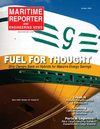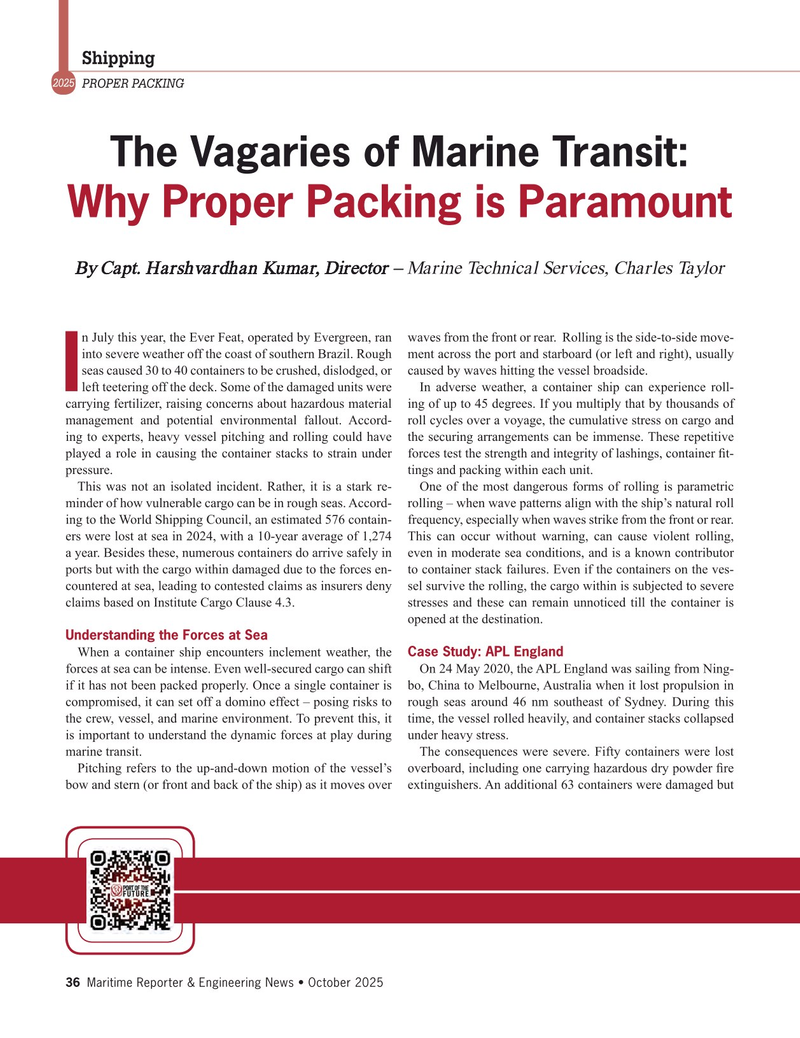
Page 36: of Maritime Reporter Magazine (October 2025)
Read this page in Pdf, Flash or Html5 edition of October 2025 Maritime Reporter Magazine
Shipping 2025
PROPER PACKING
The Vagaries of Marine Transit:
Why Proper Packing is Paramount
By Capt. Harshvardhan Kumar, Director – Marine Technical Services, Charles Taylor n July this year, the Ever Feat, operated by Evergreen, ran waves from the front or rear. Rolling is the side-to-side move- into severe weather off the coast of southern Brazil. Rough ment across the port and starboard (or left and right), usually seas caused 30 to 40 containers to be crushed, dislodged, or caused by waves hitting the vessel broadside.
Ileft teetering off the deck. Some of the damaged units were In adverse weather, a container ship can experience roll- carrying fertilizer, raising concerns about hazardous material ing of up to 45 degrees. If you multiply that by thousands of management and potential environmental fallout. Accord- roll cycles over a voyage, the cumulative stress on cargo and ing to experts, heavy vessel pitching and rolling could have the securing arrangements can be immense. These repetitive played a role in causing the container stacks to strain under forces test the strength and integrity of lashings, container ? t- pressure. tings and packing within each unit.
This was not an isolated incident. Rather, it is a stark re- One of the most dangerous forms of rolling is parametric minder of how vulnerable cargo can be in rough seas. Accord- rolling – when wave patterns align with the ship’s natural roll ing to the World Shipping Council, an estimated 576 contain- frequency, especially when waves strike from the front or rear. ers were lost at sea in 2024, with a 10-year average of 1,274 This can occur without warning, can cause violent rolling, a year. Besides these, numerous containers do arrive safely in even in moderate sea conditions, and is a known contributor ports but with the cargo within damaged due to the forces en- to container stack failures. Even if the containers on the ves- countered at sea, leading to contested claims as insurers deny sel survive the rolling, the cargo within is subjected to severe claims based on Institute Cargo Clause 4.3. stresses and these can remain unnoticed till the container is opened at the destination.
Understanding the Forces at Sea
When a container ship encounters inclement weather, the Case Study: APL England forces at sea can be intense. Even well-secured cargo can shift On 24 May 2020, the APL England was sailing from Ning- if it has not been packed properly. Once a single container is bo, China to Melbourne, Australia when it lost propulsion in compromised, it can set off a domino effect – posing risks to rough seas around 46 nm southeast of Sydney. During this the crew, vessel, and marine environment. To prevent this, it time, the vessel rolled heavily, and container stacks collapsed is important to understand the dynamic forces at play during under heavy stress. marine transit. The consequences were severe. Fifty containers were lost
Pitching refers to the up-and-down motion of the vessel’s overboard, including one carrying hazardous dry powder ? re bow and stern (or front and back of the ship) as it moves over extinguishers. An additional 63 containers were damaged but 36 Maritime Reporter & Engineering News • October 2025
MR #10 (34-45).indd 36 MR #10 (34-45).indd 36 10/2/2025 7:13:32 PM10/2/2025 7:13:32 PM

 35
35

 37
37
